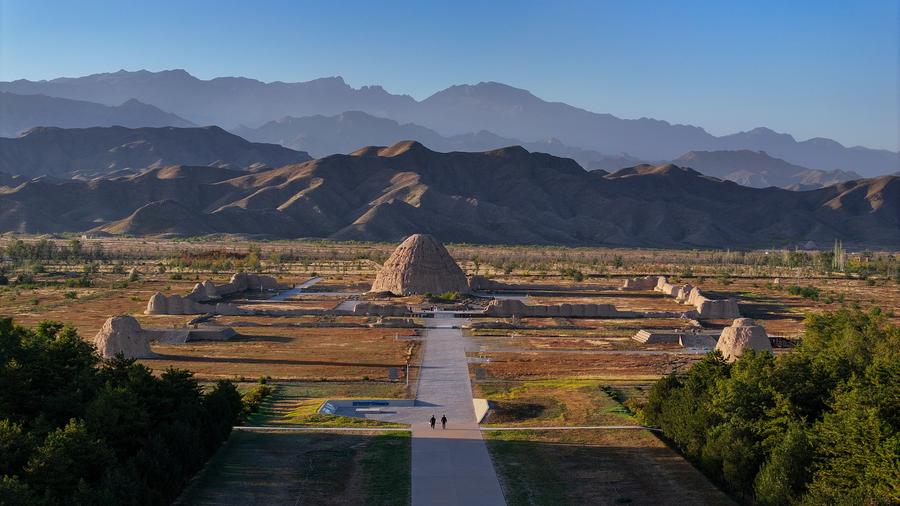Digital innovation reshapes heritage frontier for Chinese museums
From:XinhuaAuthor: 2025-05-20 14:32

An aerial drone photo taken on Oct. 10, 2024 shows a Xixia imperial tomb at the foot of Helan Mountain, northwest China's Ningxia Hui Autonomous Region. (Xinhua/Feng Kaihua)
?Digital innovation, spanning immersive exhibitions, artifact restoration and preventive conservation, is reinvigorating China's museums and transforming historical treasures into interactive storytellers.
At the foothills of the Helan Mountains in northwest China's Ningxia Hui Autonomous Region, the Xixia imperial mausoleums complex and its accompanying museum captivate travelers exploring the mysterious Tangut (Dangxiang) culture.
The ethnic group thrived in parts of northwest China between the 11th and 13th centuries, controlling key trade routes.
Preserved in a vitrine, a green-glazed Kalavinka statue, a Buddhist mythological hybrid blending human facial features with a bird body, conceals intricate carvings along its plinth.
Upon pressing the cabinet's interactive button, a magnified 3D hologram replicates every detail with vivid textual explanations of the treasure.
Visitors can manipulate the digital twin with gesture controls, rotating the virtual artifact to examine its craftsmanship from all angles and zooming in for a closer look.
"Through this device, I can magnify the details of cultural relics to see their intricate decorative patterns. It's marvelous," said a visitor from east China's Hangzhou who only gave her surname, Zhu.
The smart cultural relic display cabinet, utilizing OLED screen systems, transforms static artifacts into interactive 3D holographic projections to create immersive viewing experiences, said Shi Peiyi, curator of the mausoleum museum.
"By revolutionizing static displays through digital innovation, we create interactive storytelling that empowers visitors to decode the history embedded within relics," Shi said.
China's cultural digitization agenda gained momentum in 2021 when the central government unveiled a plan to advance the preservation of cultural relics and related technological innovation during the 14th Five-Year Plan period (2021-2025).
The policy document has driven transformative advancements. At the Sanxingdui Ruins, a Bronze Age marvel in southwest China's Sichuan Province, digital technologies have revolutionized cultural relic restoration.
Among countless unearthed fragments, AI has assisted archaeologists in identifying compatible segments for restoration. A striking example of technological achievement is a bronze statue depicting a kneeling figure atop a beast, crowned with a ceremonial vessel.
By scanning fragments to create 3D models, archaeologists employed AI to analyze geometric patterns, calculate alignment probabilities and simulate structural stability.
Through this approach, researchers collected fragments from separate excavation sites to reconstruct this sculpture.
The digital revitalization of the Ya'er Lake Grottoes, a part of the Jiaohe Ruins along the ancient Silk Road in Xinjiang Uygur Autonomous Region, further exemplifies China's efforts to preserve and display cultural relics.
Following a 12-month conservation project, the grottoes opened to the public in April.
Through AR-enabled devices, visitors can immerse themselves in the regenerated murals, with the serene countenance of Buddhist deities clear for all to see.
"The restoration team achieved high-precision reconstruction of the grotto murals and generated accurate datasets for academic research," said Wang Jiandong, head of the Jiaohe Ruins administrative office.
"Digital technology has allowed us to transcend the longstanding dilemma of whether to preserve relics or display them to the public, while authentically recreating the artistic grandeur of the grottoes," Wang added.
Empowered by digital technologies, museum visitor engagement is undergoing a leap, driving a surge in attendance. During the recent May Day holiday, over 60.49 million visitors flocked to museums across China within five days, setting a new record.
Museums have emerged as dynamic hubs, drawing diverse visitors. This "museum fever" stands as a testament to the progress of Chinese society, said Liu Shuguang, chairman of the Chinese Museums Association.
Edit:董麗娜
The copyright of the article and the picture belongs to the original author. If there is any infringement, please contact to delete it